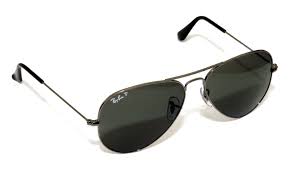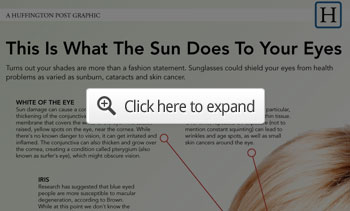|
| |
Common Myths About Sunglasses That Can Hurt You
Main
Article page |
Beauty articles
|
Health page |
Computers|
Diseases |
Education |
Entertainment |
Family
Business |Fitness|
Fruits and Vegetables
|
Jobs |
General |
Personality|
Technology
|
Tourism |
Useful Tips
General Knowledge |
Biography Page|
Heroes & Incredible peoples
|
Inventions
Health Page|
Diseases and Remedies |
Articles|
List of diseases
| Dentistry

Virtually all parts of your eye, including the skin around it,
can be damaged by excessive sun exposure, but your eyes also need exposure to
full-spectrum light to function optimally
Avoid wearing sunglasses during all daylight hours, as this will block
beneficial wavelengths of light from reaching your eyes
Reserve your sunglasses for high-exposure activities, such as downhill
skiing or water activities; a hat with a brim will generally provide adequate
sun protection for your eyes the rest of the time
When choosing sunglasses, look for a label that says 99-100 percent UV
absorption or UV 400 (which means they block all UVA and UVB rays)
By Dr. Mercola
Just as a natural, non-toxic sunscreen can be
beneficial when you’re going to be exposed to excessive amounts of sunlight,
sunglasses, too, have their place.
If you’re downhill skiing or out on the water, sunglasses can help to shield
your eyes from sun damage … however, I don’t personally wear them for many
occasions other than this, for reasons I’ll explain shortly.
That said, too much sun can potentially damage the skin around your eyes,
your lens and increase your risk of cataracts. So when choosing sunglasses
it’s important to know what qualities to look for.
How Can the Sun Damage Your Eyes?
Just like your skin, your eyes are
susceptible to damage from too much sun exposure. The skin around your eyes,
including your eyelids, is among the thinnest and most sensitive on your
body, making it particularly vulnerable to wrinkling and age spots from
excessive exposure to ultraviolet (UV) rays.
However, even your eyes themselves can be damaged by too much sun:1
-
The white of your eye: Sun
damage may cause the conjunctiva, the thin membrane covering the white
of your eye, to thicken and become irritated and inflamed. If the
conjunctiva thickens and grows over your cornea (called pterygium or
‘surfer’s eye’), it can interfere with your vision.
-
Retina: If
the macula, a part of your retina, deteriorates, it can lead tomacular
degeneration, a leading cause of blindness. There is some evidence of a
link between macular degeneration and exposure to UV light. Astaxanthin
is also useful here, as it has been shown to prevent and treat
age-related macular degeneration.
-
Iris: If you
have blue eyes, you may be more susceptible to UV-induced eye damage,
including macular degeneration.
-
Lens: UV
light may lead to the development of certain types of cataracts, which
is a cloudiness on the lens of your eye that can also interfere with
your vision.
-
Cornea: Your
cornea can become acutely sunburned, causing serious pain and temporary
blindness. Chronic excessive exposure can lead to cataracts, especially
if you have a poor diet with low antioxidants.
Keep in mind, too, that certain medications can increase your eye’s
sensitivity to the sun. This includes drugs such as birth control pills,
diuretics, tranquilizers, tetracycline and sulfa drugs.
Continued down....
What Should You Look for in a Pair of Sunglasses?
For the times when you need serious sun
protection for your eyes, not all sunglasses are created equal. You can’t
use price as a gauge of quality, either, as many of the higher priced brands
cost more because of fashion, not function. Some quick tips to ensure you’re
getting a high-quality pair include:
-
Avoid sunglasses that simply say “absorbs UV,” instead look for a label
that says 99-100 percent UV absorption or UV 400 (which means they block
all UVA and UVB rays)
-
Polarized lenses help cut glare allowing for crisper vision, but they do
not add sun protection
-
Darker lens colors don’t necessarily mean better sun protection, as the
UV protectant added to lenses is clear; even gray, green, yellow or rose
lenses can offer adequate UV protection
-
Sunglasses made from pressed plastic will lead to distorted vision when
you look to the right or left; choose sunglasses with optically ground
lenses for less distortion
-
Larger frames and wraparound styles will shield more UV rays than
smaller styles, as will close fitting glasses
The infographic below, from The Huffington Post, sums up this information
nicely:2

Be Careful of ‘Sunglasses’ Called ‘Eyeware’ or ‘Sunware’
If you purchase a pair of sunglasses,
they must offer some level of UV protection. This level could vary, however,
which is why it’s best to look for those that specify a certain level, such
as UV 400 or 100 percent UV absorption, as mentioned. Because the US Food
and Drug Administration (FDA) only regulates whether companies adhere to the
labeling, if your sunglasses claim to be “100 percent UV protected,” they
must live up to that claim.
That said, there are other types of glasses on the market that are marketed
as sunglasses but are actually called:
-
Sun blockers
-
Polarized glasses
-
Eyeware
-
Sunware
In these cases, they may offer no UV
protection at all, yet would still be allowed under the FDA rules because
they’re not technically called ‘sunglasses.’ There are also so-called
‘cosmetic’ sunglasses, which typically block only about 70 percent of UV
rays.
Again, remember that price is not an indicator of quality sun protection.
CBS News actually did a study comparing cheap sunglasses ($5 a pair) to
high-end brands like Versace ($200 a pair). All 31 pairs carried claims that
they offered excellent UV protection… and all but one (a cheap pair)
actually did.3 In
other words, if your sunglasses claim to offer good UV protection, they
probably do. But, if you’re uncertain, take them in to an eye center.Most
will test the UV protection level of your sunglasses for free, and it takes
less than 30 seconds to do so.
Why I Rarely Wear Sunglasses
As I mentioned, I only wear sunglasses on rare
occasions, such as when I’m downhill skiing or, sometimes, if I’m boating on
the water. Under these conditions, the snow or water greatly magnifies the
sunlight, which could potentially be harmful, especially after hours of
exposure.
On an average sunny day, however, wearing sunglasses is the last thing
you want to do for your vision health, because you will be blocking
potentially beneficial wavelengths
of light from reaching your eyes. There are actually more than 1,500
wavelengths of light that you need to nourish your eyes. So I avoid using
sunglasses, because I believe your eyes need to receive the full spectrum of
light to function optimally, and sunglasses block out some essential waves
of the light spectrum.
Instead of sunglasses, I wear a lightweight
cap with a visor like this one to
protect my face and eyes from direct sunlight. This is typically all that is
needed and will still allow your eyes to benefit from the full spectrum of
light. My team liked the cap that I wear so much that we even offer
it for sale in our store.
Your Body Needs Exposure to Bright Light During the Day
There’s another reason why you need to be
careful about overly shielding your eyes from sunlight, and that is because
when full-spectrum light enters your eyes, it not only goes to your visual
centers enabling you to see, it also goes to your brain's hypothalamus where
it impacts your entire body.
Your hypothalamus controls body temperature, hunger and thirst, water
balance and blood pressure. Additionally, it controls your body's master
gland, the pituitary, which secretes many essential hormones, including
those that influence your mood. Exposure to full-spectrum lighting is
actually one effective therapy used for treating depression, infection,
and much more.
Studies have also shown that poor lighting in the workplace triggers
headaches, stress, fatigue and strained watery eyes, not to mention inferior
work production. Conversely, companies that have switched to full-spectrum
lights report improved employee morale, greater productivity, reduced errors
and decreased absenteeism. Some experts even believe that “malillumination”
is to light what malnutrition
is to food.
Your ‘body clock’ is also housed in tiny centers located in the
hypothalamus, controlling your body’s circadian rhythm. This light-sensitive
rhythm is dependent on Mother Nature, with its natural cycles of light and
darkness, to function optimally. Consequently, anything that disrupts these
rhythms, like inadequate sunlight exposure to your body (including your
eyes), has a far-reaching impact on your body’s ability to function. The
best way to get exposure to healthy full-spectrum light is to do it the way
nature intended, by going out in the sun with your bare skin – and ‘bare’
eyes -- exposed on a regular basis.
Have You Heard of Sun Gazing?
Sun gazing originated in India more than 2,000
years ago, although it was also practiced by ancient Egyptians, Aztecs,
Greeks, Mayans, in Tibetan Yoga and some traditions of Qigong, Tai Chi, and
by some Native American tribes. Sun gazing -- also known as solar healing,
solar gazing, sun staring, Sun Yoga, Surya Yoga and Solar Yoga -- refers to
the practice of staring directly at the sun in order to receive nourishment,
healing and spiritual enlightenment. The gazing is done only during the
first hour after sunrise or the last hour before sunset, when the sun’s rays
are most gentle to your eye. If
you perform it at other hours you can cause serious damage to your retina.
It’s interesting to note that your pineal gland (aptly named your “third
eye” considering its anatomical location and the fact that it contains
light-sensitive cells) is also activated by light. Light reaches it by
passing into your eyes, then along a pathway from your retina to your
hypothalamus called the retinohypothalamic tract, then along nerve pathways
to your pineal gland.
Light impulses inhibit the production of melatonin, and at night when it is
dark, pineal inhibition ceases, and melatonin is released. Therefore, the
pineal gland is an important timekeeper for your body. Melatonin is also
produced during visualization and relaxation. It’s thought that the light
energy you take in while sun gazing activates your dormant pineal gland,
which then turns your “brainuter” on. It is this activation that causes you
to experience the seemingly magical conversion of sun energy into nutrition,
healing of disease, heightened energy, increased psychic abilities and,
ultimately, enlightenment.
Sun gazing is highly controversial due to the considerable evidence, which
states that looking directly at the sun can be damaging to your eyes. So
while I am not advocating gazing into the sun directly, I think it’s
important to reflect on this phenomenon that is already occurring, and from
which many have experienced benefits. If you’d like to learn
more about sun gazing (which
you should definitely do
before attempting it), you can do
so here.
Use Your Body as Your Sunglasses Guide
Remember, when you eat a high-quality
nutritious diet, you load your body with magnificent antioxidant
protection so the need for some of these issues becomes diminished the
higher the quality of your diet is. You can also improve your protection by
using targeted antioxidants, like astaxanthin, which is a carotenoid shown
to prevent and treat age-related macular degeneration.
There’s a lot we’re still learning about the sun and how it influences human
health … and, conversely, how the use of man-made sun-blocking devices like
sunglasses may negatively alter our well-being.
Generally speaking, I think you can effectively use your body as a guide to
tell you when sunglasses are truly necessary. If the light is uncomfortable
to your eyes or causes you to squint, put on a hat, get in the shade or use
sunglasses – temporarily.
But I believe it’s best to avoid wearing
sunglasses automatically during virtually all daylight hours.
| |
|




